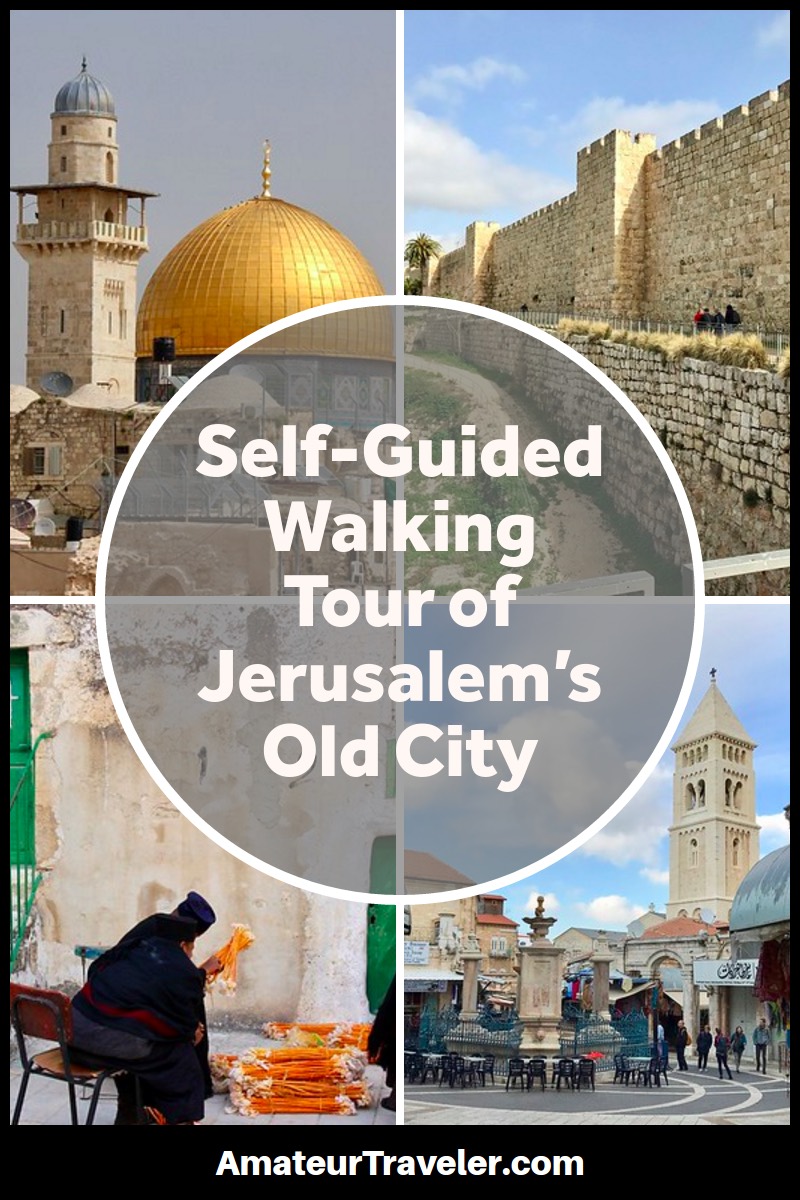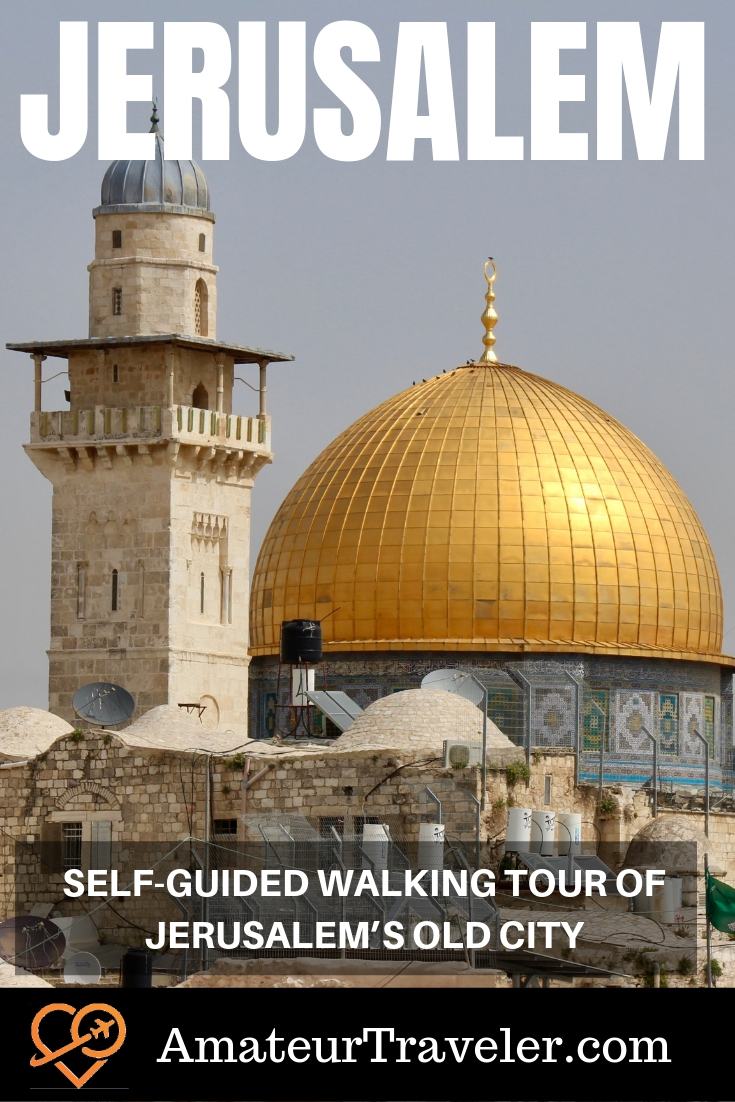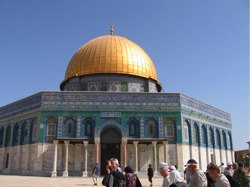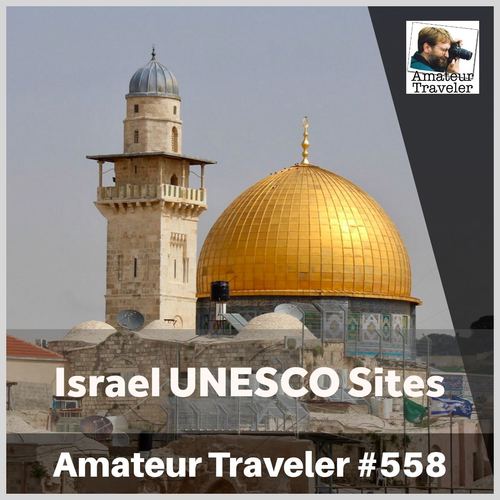Free Self-Guided Walking Tour of Jerusalem’s Old City (with Map)
categories: asia travel, middle east travelThe Old City of Jerusalem is an amazing site and amazingly small when you consider all the significant sites it contains. It is around one square kilometer. I had a chance to visit Jerusalem for the first time recently when I attended the TBEX conference there. While I was there I took a walking tour from Sandeman. This is what I learned on that tour and on my own explorations.

Table of contents: ()
Map Self-Guided Walking Tour of Jerusalem’s Old City

The Ancient Walled City
Jerusalem has been conquered by a great number of civilizations over the centuries including the Babylonians, the Romans, the Arabs, the Crusaders, the Turks, and the British. When you look at the old walled city today you are looking at the walls built later in the cities history, completed in 1541 by the Ottoman ruler Suleiman the Magnificent. You can get a good view of the city by walking these walls.
For centuries after these walls were built, they defined the extent of the city of Jerusalem as people were afraid to live outside of the protection of the walls. The new city did not really get started until 1860 and at first, people had to be paid to live outside the safety of the walls.

The Jaffa Gate
Most tourists will enter the city on the west side through the Jaffa Gate. Just inside the Jaffa gate to the left is one of the entry places where you can start a walk along the walls.
If you have questions the tourism information center is also just inside that entrance. Pick up a free map, because you will need it. If you don’t have a data service download a good offline map like those from maps.me on your smartphone before you leave your hotel or hostel.

When I was visiting the city, they were doing a series of free concerts in the evenings and had stages both inside and outside of the Jaffa Gate.

The Tower of David
Just to the left of the Jaffa gate, you will see the tower of David, which has nothing to do with King David. Early pilgrims visiting the city read in their bibles that David built a tower and assumed that this must be it, but David’s city is outside the old walls to the south and down the hill from the old city. You can now visit the archaeological site where they are uncovering this city just outside the Dung Gate. You can also visit David’s tomb just outside of the Zion Gate.
This tower was first built by Herod the Great who also rebuilt the temple just before the time of Christ. Look at this tower closely and you will see signs of 3 different eras. The base of the tower was built by Herod, the moat around it by the crusaders and the top of the tower by the Mamluks who re-conquered the city from the crusaders.

Inside of the tower is an excellent museum, that I highly recommend, that explains the history of this complicated city.

Come back to the Tower of David at night to see the light show that is displayed on the battlements for a more colorful artistic version of the history of the city.
The Armenian Quarter
If you turn to the right from the Jaffa Gate and come around the Tower of David you can enter the Armenian quarter through the narrow Armenian Patriarchate St. The Armenians were the first country in the world to accept Christianity as a state religion and the Armenian quarter is one of the oldest areas in the Old City. It is also the least populated and the least open to visitors.
Follow this street down to St James St (and we are using the term street here very generously). Where these two meet is the Cathedral of St James which has the highest concentration of Saints named James buried here of any place in the world. According to Armenian tradition, the head of St James, son of Zebedee, (brother of John) and the body of St James the Just (brother of Jesus) are both buried in this church. St James the son of Zebedee was the first of the apostles to be martyred and the only one (besides Judas) whose death is mentioned in the bible. This church is opened very limited hours for tourists, only during services.

Take St James street until you reach Ararat St and turn left. This street is named after the mountain which was historically in Armenia (and now is just outside their boundaries in Turkey) where the ark of Noah came to rest after the flood. The mountain is sacred to Armenians. If you see a prelate walking down the street wearing a black pointed hat, that would be an Armenian Christian priest and the shape of the hat is to remind you of the mountain of Ararat. Continue down this street until you get to the church of St Mark.

Armenian tradition has it that the church of St Mark was built on the site of the upper room where Jesus and his disciples ate the last supper. Like she many thing sin Israel, there are often more than one site associated with any particular biblical event. Other traditions place the site of the upper room just outside the Zion Gate near the tomb of David.
The Roman Cardo
After the church make a quick right on Or HaHayim St. Take a right on Habad St, the first left and the first left again to get onto Ha Yehudim St. This is where your map is going to be very helpful.

In the Jewish quarter, you can find where archeologists have uncovered the Roman Cardo, or the marketplace from the Roman era. You will have to climb down some steps as the street level of the city today is about one story taller than it was then. Here you will see an artist’s rendition of a Roman market (with one modern small boy added). You will also find the original paving stones where Jesus and others from that time walked while shopping.
- Book Your Accommodation HERE
- Search for Great Tours HERE
- Get a Car Rental
- Get a universal plug adapter
- Buy Travel Insurance
- Get an eSim to be able to use your smartphone abroad.

The Jewish Quarter
The Jewish quarter has some of the newest construction in the city as much of it was destroyed in the 6 Day War.

For religious Jews, the most sacred spot in the world is the Temple Mount. Not only is this where Abraham was asked to sacrifice Isaac (spoiler, it was a test, God stopped him) but they also believe that the stone where God stood to create the world now sits under the Dome of the Rock. For the very religious, even if they were allowed to climb to the top of the Temple Mount, they should not because they might accidentally come into contact with the Holiest of Holies which is where the presents of God dwelled in the temple.

The Western Wall is a place where the stones of the Second Temple are exposed and is, therefore, a sacred site for religious jews. Men pray on the left and women on the right. You can approach the Western Wall but use discretion as this is a very sacred site. You will have to pass through a security checkpoint to reach the Western Wall.

On Mondays and Thursdays, you will see many young boys celebrating their bar mitzvah. Look for the many Torahs near the wall itself.

Or look for the jubilant parades of boys, parents, friends, relatives, and musicians coming in from the Dung Gate to the right of the Western Wall.

The Temple Mount
The most photographed building in Jerusalem is probably the Dome of the Rock which has a gilded dome. This building sits on the stop where the Jewish temple was built (and rebuilt). Muslims believe that Mohammad traveled one night from Mecca to the “furthest mosque” or the “most extreme mosque” upon a magical flying beast.

This mosque is believed to be the Al-Aqsa Mosque which is the more nondescript large building on the Temple Mount, next to the Dome of the Rock. This mosque is held by most Muslims to be the 3rd most holy site after Mecca and Medina.

The koran states that Mohammad ascended into heaven from the spot where the Dome of the Rock sits. He then negotiated with God for how often Muslims would need to pray during the day. He haggled God down from 50 times a day down to the current 5 times a day, after some prompting from Moses. Haggling skills still come in handy in Jerusalem.
Only Muslims are allowed to enter either the Dome of the Rock or the Al-Aqsa Mosque. Non-muslims can visit the outside of the buildings but not during times of prayer. One of the best times to come is early in the morning after morning prayer.

At the Western Wall, you will see a wooden ramp that climbs to the Temple Mount. Exit the secure area of the Western Wall towards the Dung Gate and then queue up to reenter another security check to climb up the ramp. The ramp is also a great place to take pictures of the Western Wall without disturbing those who are praying there.
Religious displays for non-Muslims are forbidden on the Temple Mount. Bringing Jewish prayer books, Talit, or Tefilin is forbidden. If you are Jewish, there is a decent chance you will be turned away. Wearing a Kippah will significantly decrease your chances of gaining admission.

David Street
You will exit the Temple Mount from a different gate than you enter, coming out near David street which is a central narrow market street that heads back towards the Jaffa Gate. Take your time bargaining your way along the street if you so desire as the climb back up the hill towards the Christian Quarter.

Christian Quarter
Follow signs from David street to the Church of the Holy Sepulcher. There will be more shops and restaurants along the way and unless you are there very early in the morning, larger groups of pilgrims should be expected.

Church of the Holy Sepulcher

One of the top churches in Jerusalem to see is the Church of the Holy Sepulcher which is two different holy sites for Christians combined into one. Although it is hard to picture, just up the steps on your right when you enter the church is the rock of Golgotha where Jesus was crucified. You will see pilgrims queue up to touch the spot where the cross stood which is now under an altar. All of this was not just outside of a church but outside of the city walls in the 1st century.

Just in front of you as you enter the church is the stone where tradition has it that the body of Jesus was prepared for burial.

To the left from the entrance of the church is a tabernacle or building beneath the left of the church’s two domes. Inside this structure is what is left of the cave where, according to tradition, Jesus was buried. It is hard to picture this as a cave these days. The church opens at dawn and the easiest time to see this area without waiting in long lines is to do it early. I was fortunate to enter the church the first time during a service when the building was filled with chanting, singing, and organ music from a worship service.
The church is in surprising disrepair, although a recent renovation did remove centuries of soot from candles. But still, the floor is in need of repair in many places. The church is shared by 5 different denominations of Christians and all must agree to any changes which means in practice that the church is held in a state of status quo.

Just to the right and outside of the entrance there are steps that go up to a chapel of the Ethiopian church, which is worth a quick visit.

Also, continue on up to a courtyard where I found this group of priests.
Guided Tours
If you are afraid you will get lost… and you probably will or you want a great tour guide there are a number of good guided tours of the Old City.
Conclusion
From the church, you can either make your way back to the Jaffa Gate or you can continue on into the Christian quarter and Muslim quarter to trace the route of the Via Dolorosa. This is the route that Jesus took to the cross, so it starts near the Lion gate and ends at the Church of the Holy Sepulcher.
Whatever your faith or lack thereof, Jerusalem is a fascinating place that everyone should visit at least once.

+Chris Christensen | @chris2x | facebook
13 Responses to “Free Self-Guided Walking Tour of Jerusalem’s Old City (with Map)”
Leave a Reply
Tags: article, best, day tour, featured, israel, jerusalem, self-guided tour, walking tour

 Travel to Jerusalem – Episode 192
Travel to Jerusalem – Episode 192 Israel Travel Advice – What to Know Before Your First Trip
Israel Travel Advice – What to Know Before Your First Trip 4 Day Road Trip in Israel – Biblical Sites, Ruins, Castles & Humus
4 Day Road Trip in Israel – Biblical Sites, Ruins, Castles & Humus UNESCO World Heritage Sites of Israel and Palestine – Episode 558
UNESCO World Heritage Sites of Israel and Palestine – Episode 558

Agness
Says:January 9th, 2019 at 4:34 am
Hi Chris, its a learning experience for me reading this article of yours.. Captivated by the images. Thanks
Peter T Sadow
Says:January 13th, 2019 at 9:22 am
If you are going to post a free walking tour, why not include a path on the map? That would be useful. A google map image of the locations is not useful. You are just being used to advertise a paid walking tour, not a free one.
chris2x
Says:January 13th, 2019 at 10:10 am
Sorry, let me see if I can add the path on the map
Sarita Noronha
Says:January 31st, 2019 at 1:25 pm
What time does the walking tour start on Friday?
chris2x
Says:January 31st, 2019 at 5:36 pm
I don’t know.
Nir
Says:March 17th, 2019 at 3:51 am
it is a pity that you have not visited David’s tower laser show in Jerusalem. Also there is a great park The first station.
it’s worth it to come back
piya chakravarty
Says:January 8th, 2020 at 8:15 am
Show a path that can be used easily by visitors who are mobility challenged instead of having to walk long distances which take you nowhere or to sites you don’t want to visit
April
Says:February 25th, 2020 at 7:13 pm
Thanks for this great guide! Very helpful!
Chris Christensen
Says:February 25th, 2020 at 10:52 pm
You are most welcome April
Mike
Says:June 3rd, 2022 at 4:56 pm
You mention much of the Jewish Quarter being destroyed during the Six-Day War. Was not the bulk of the damage at the end of the War of Independnce when Jordan blew up, pillaged, etc. the Jewsih buildings, including the Hurva Synagogue?
Chris Christensen
Says:June 4th, 2022 at 9:21 am
I do not know Mike.
Julie
Says:June 14th, 2023 at 6:23 am
Thanks for the great info. Followed your path today and it was great.
Chris Christensen
Says:June 14th, 2023 at 7:11 am
great!